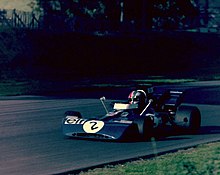The Tyrrell Racing Organisation was an auto racing team and Formula One constructor founded by Ken Tyrrell (1924–2001) which started racing in 1958 and started building its own cars in 1970. The team experienced its greatest success in the early 1970s, when it won three Drivers' Championships and one Constructors' Championship with Jackie Stewart. The team never reached such heights again, although it continued to win races through the 1970s and into the early 1980s, taking the final win for the Ford Cosworth DFV engine at the 1983 Detroit Grand Prix. The team was bought by British American Tobacco in 1997 and completed its final season as Tyrrell in the 1998 Formula One season. Tyrrell's legacy continues in Formula One as the Mercedes-AMG F1 team, who is Tyrrell's descendant through various sales and rebrandings via BAR, Honda, and Brawn GP.

The 1969 German Grand Prix was a Formula One motor race held at Nürburgring on 3 August 1969. It was race 7 of 11 in both the 1969 World Championship of Drivers and the 1969 International Cup for Formula One Manufacturers. Twelve Formula Two cars were also entered into the race, though they were not eligible to score points.
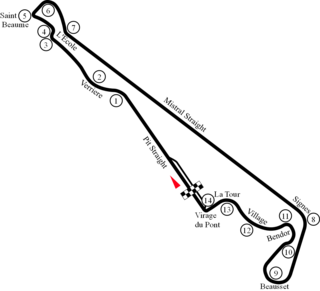
The 1971 French Grand Prix was a Formula One motor race held at the Circuit Paul Ricard on 4 July 1971. It was race 5 of 11 in both the 1971 World Championship of Drivers and the 1971 International Cup for Formula One Manufacturers. The 55-lap race was won by Tyrrell driver Jackie Stewart after he started from pole position. His teammate François Cevert finished second and Lotus driver Emerson Fittipaldi came in third.

The 1971 Austrian Grand Prix was a Formula One motor race held at Österreichring on 15 August 1971. It was race 8 of 11 in both the 1971 World Championship of Drivers and the 1971 International Cup for Formula One Manufacturers. The 54-lap race was won by BRM driver Jo Siffert after he started from pole position. Emerson Fittipaldi finished second for the Lotus team and Brabham driver Tim Schenken came in third. This was the debut race of the future world champion Niki Lauda.

The 1971 Italian Grand Prix was a Formula One motor race held at Monza on 5 September 1971. It was race 9 of 11 in both the 1971 World Championship of Drivers and the 1971 International Cup for Formula One Manufacturers.

The 1971 United States Grand Prix was a Formula One motor race held on October 3, 1971, at the Watkins Glen Grand Prix Race Course in Watkins Glen, New York. It was race 11 of 11 in both the 1971 World Championship of Drivers and the 1971 International Cup for Formula One Manufacturers. The 59-lap race was won by Tyrrell driver François Cevert after he started from fifth position. Jo Siffert finished second for the BRM team and March driver Ronnie Peterson came in third.

The 1972 United States Grand Prix was a Formula One motor race held on October 8, 1972, at the Watkins Glen Grand Prix Race Course in Watkins Glen, New York. It was race 12 of 12 in both the 1972 World Championship of Drivers and the 1972 International Cup for Formula One Manufacturers. The 59-lap race was won by Tyrrell driver Jackie Stewart after he started from pole position. His teammate François Cevert finished second and McLaren driver Denny Hulme came in third. This was the debut race of the future world champion Jody Scheckter.

The 1973 Grand Prix of Sweden was a Formula One motor race held at the Scandinavian Raceway, Anderstorp on 17 June 1973. It was race 7 of 15 in both the 1973 World Championship of Drivers and the 1973 International Cup for Formula One Manufacturers. The 80-lap race was won by McLaren driver Denny Hulme after he started from sixth position. Ronnie Peterson finished second for the Lotus team and Tyrrell driver François Cevert came in third.

The 1973 United States Grand Prix was a Formula One motor race held on October 7, 1973 at the Watkins Glen Grand Prix Race Course in Watkins Glen, New York. It was race 15 of 15 in both the 1973 World Championship of Drivers and the 1973 International Cup for Formula One Manufacturers.
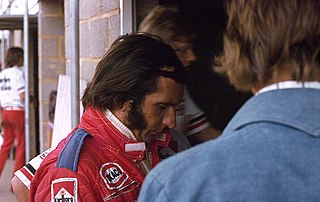
The 1974 Formula One season was the 28th season of FIA Formula One motor racing. It featured the 1974 World Championship of F1 Drivers and the 1974 International Cup for F1 Manufacturers, contested concurrently over a fifteen-race series which commenced on 13 January and ended on 6 October. The season also included three non-championship races.
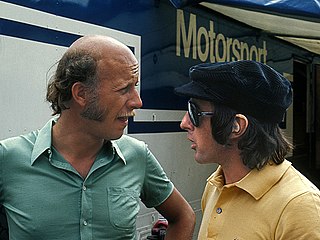
The 1973 Formula One season was the 27th season of FIA Formula One motor racing. It featured the 1973 World Championship of Drivers and the 1973 International Cup for F1 Manufacturers, which were contested concurrently over a fifteen-race series that commenced on 28 January and ended on 7 October. The season also included two non-championship races which were open to both Formula One and Formula 5000 cars.

The 1972 Formula One season was the 26th season of the FIA's Formula One motor racing. It featured the 23rd World Championship of Drivers, the 15th International Cup for F1 Manufacturers, and numerous non-championship Formula One races. The World Championship commenced on 23 January and ended on 8 October after twelve races.

The 1971 Formula One season was the 25th season of the Fédération Internationale de l'Automobile's Formula One motor racing. It featured the 22nd World Championship of Drivers, the 14th International Cup for F1 Manufacturers and a number of non-championship races open to Formula One cars. The World Championship was contested over eleven races between 6 March and 3 October.

The 1970 Formula One season was the 24th season of the Fédération Internationale de l'Automobile's Formula One motor racing. It featured the 21st World Championship of Drivers, the 13th International Cup for F1 Manufacturers and three non-championship races open to Formula One cars. The World Championship was contested over thirteen races between 7 March and 25 October.
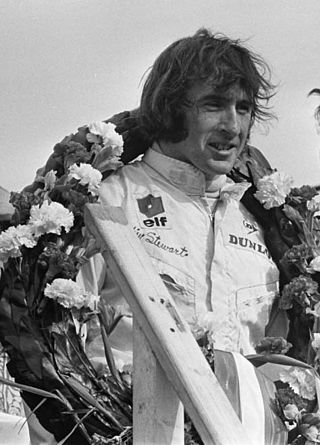
The 1969 Formula One season was the 23rd season of the FIA's Formula One motor racing. It featured the 20th World Championship of Drivers, the 12th International Cup for F1 Manufacturers and four non-championship races open to Formula One cars. The World Championship was contested over eleven races between 1 March and 19 October 1969.

The 1968 Formula One season was the 22nd season of the FIA's Formula One motor racing. It featured the 19th World Championship of Drivers, the 11th International Cup for F1 Manufacturers, and three non-championship races open to Formula One cars. The World Championship was contested over twelve races between 1 January and 3 November 1968.
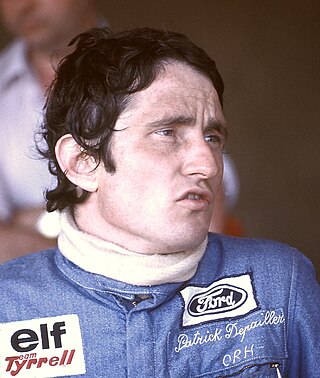
Patrick André Eugène Joseph Depailler was a French racing driver, who competed in Formula One from 1972 to 1980. Depailler won two Formula One Grands Prix across eight seasons.

Peter Kenneth Gethin was a British racing driver and motorsport executive, who competed in Formula One from 1970 to 1974. Gethin won the 1971 Italian Grand Prix with BRM.

The Tyrrell 006 was a Formula One car designed and built by the Tyrrell Racing Organisation. It was introduced towards the end of 1972. In the hands of Jackie Stewart it won the Drivers' Championship for the 1973 Formula One season, Stewart's third and final title. The car was first raced at the 1972 Canadian Grand Prix with Stewart's teammate and protégé François Cevert at the wheel. The 006 was a very slightly reworked version of the preceding Tyrrell 005 car, but in contrast it was the first Tyrrell-built models to be replicated, the number 006 becoming a model- rather than chassis-number; previous Tyrrells were one-off constructions. In total there were three Tyrrell 006 chassis built: 006; 006/2; and 006/3. The 006 model was gradually phased out in the early part of the 1974 Formula One season as Tyrrell constructed the succeeding Tyrrell 007.

The Tyrrell 002 is a Formula One racing car which was designed for the 1971 and 1972 Formula One seasons by Tyrrell's Chief Designer, Derek Gardner. It was essentially the same design as the Tyrrell 001, but incorporated some detail changes, and 002 were built with longer monocoques, as François Cevert was taller than Jackie Stewart.

